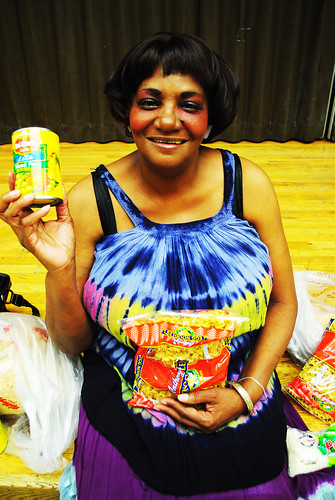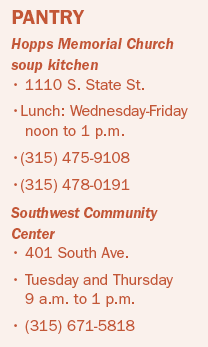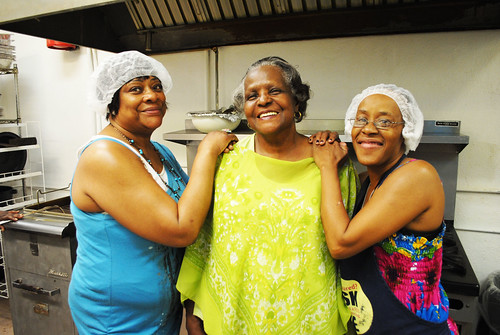Syracuse community members depend on pantries for nutrition
Verleen Innis has a fresh and deep, pink scratch near her left eye. It’s not her first — nor is the story behind it a new one.
The 54-year-old South Side resident says she tries to ration the food she gets from pantries, but it is tough for her and her disabled son, who requires more to eat than she can afford.

“My son is 27 years old and has Down syndrome,” Innis said. “I got this scratch because he got mad that I wouldn’t let him get a hot dog, so he jumped up and scratched me, so I ended up cooking the hot dog.” Innis was trying to stretch out the meat she had in her refrigerator to last her for a few more days. It wasn’t the end of the month yet, when she could return to a pantry to get more. Innis said she’d been unable to find work because of the demands of caring for her son.
One pantry Innis depends on is the Southwest Community Center Food Pantry that provides food every Tuesday and Thursday from 9 a.m. to 1 p.m. Joanne Brown Stephens, 43, program manager of the center’s Family 1st, food pantry and lead programs, has seen more residents like Innis coming every month to stock up on food since starting with the center in 2010. “I hear residents talking amongst each other about how tough it is for them not to go hungry because these economic times are affecting them,” Stephens said.
“People who never thought they would need help from a food pantry are now coming in to get food.”
Innis said people don’t get enough help when they need it. “I only get $86 for food stamps per month and I never knew that I would be coming to pantries and depending on them to get me through the month.”
Innis uses her $86 to buy meat and cheese for two of her grandchildren and her son. “I can barely get enough food for all of us,” she said. “But I won’t apply to welfare for my grandchildren because they will make me go through a whole challenge of paperwork, so I just raise my grandchildren with my little check,” Innis said.
Innis said she also has to worry about paying other bills. “When you’re the only person paying for a $400 rent, furniture bills, life insurance bill, you have to sacrifice a lot of things, and food is one that unfortunately is sacrificed.”
The Southwest Community Center has seen an increase of about 25 percent over the past five years in community residents needing the food pantry. Valerie Hill, director of Community Services for two years, said 60 people a month use t he food pantry. “If you add the amount of people who come in for our Fresh Food Giveaway once a month, the number increases to over 100 people.”
he food pantry. “If you add the amount of people who come in for our Fresh Food Giveaway once a month, the number increases to over 100 people.”
Southwest Community Center provides residents with canned food, bags of rice, pasta and cereal, as well as poultry. “I am grateful to the center because they help me get through the months,” Innis said. “I don’t care how little or how big the bag is, because whatever they give me will help feed my family.”
Churches serving warm meals have seen an uptick in traffic throughout the week.
Emma McDonald, 74, director of the Hopps Memorial Church soup kitchen, has seen a 50 percent to 75 percent increase in residents coming in to get a hot plate. “We started this program in 1979 and since about the 1980s, the dependency on food that residents need has escalated greatly. I have seen it increase, and it will continue to increase until the government says, ‘We are going to make sure that everyone in America does not go to bed hungry.’”
Hopps Soup Kitchen provides meals Wednesday through Friday from noon through 1 p.m. and provides a different meal every day. Glen Lyles, 56, volunteer at Hopps, enjoys knowing that she is helping out community members.

“I feel great when I come in because although I may be washing dishes or making 100 tuna sandwiches and putting them in bags, I know that I’m helping someone out in the community not go hungry for the day,” she said.
The South Side experience is happening nationwide. According to the Household Food Security in the United States research done for 2010, 17.2 million households across the country were food insecure, meaning they didn’t eat three meals per day. It’s the highest number ever recorded in the United States.
“There are a lot of churches now that are providing soup kitchens or pantries to community members,” Hill said, “so it’s good to see that more people are catching on to this problem that exists in our community.”
 The Stand
The Stand

